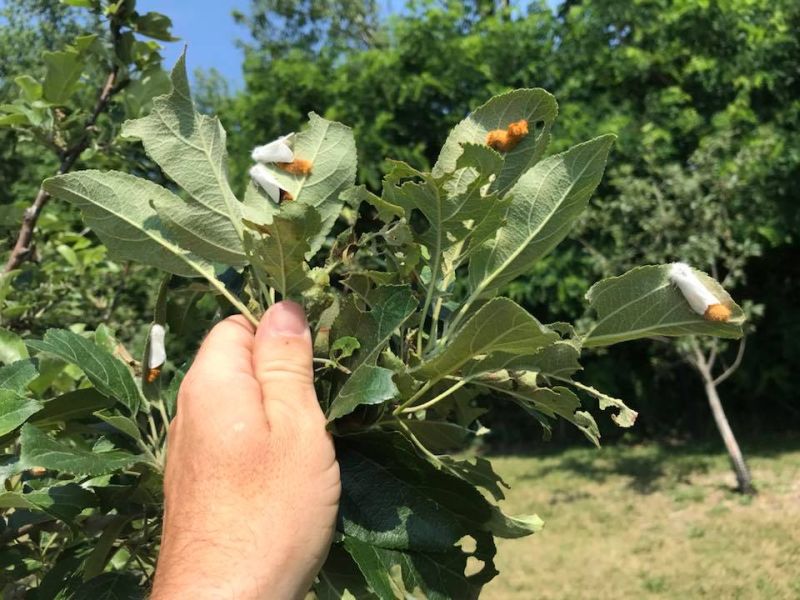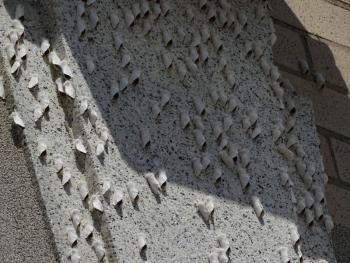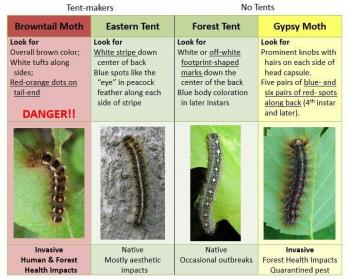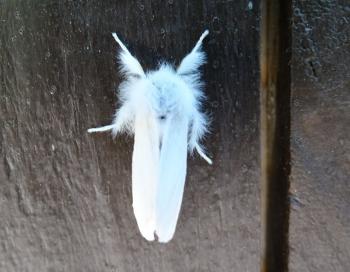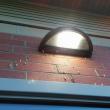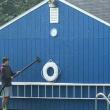UPDATE: The brown tail moths are in caterpillar stage now, and plenty of sightings have been taking place this spring. If there is any encouraging news about these caterpillars and moths that cause rashes and other human health issues, is that a fungus has been attacking the browntail population.
The Maine Forest Service reported on May 29:
Now is the time of the year that the caterpillars have begun to wander, so homeowners should be cautious around their property as caterpillars might be present on decks and the sides of houses. As the caterpillars mature, they will begin to wander. It is from this point through the end of the adult activity that you can most easily spread browntail moth to new areas. Caterpillars, pupae and adults can all travel with you, in or on your vehicle. We borrow the "look before you leave" message from our counterparts at the Pennsylvania Department of Agriculture Spotted Lanternfly Program and likewise urge you to check your person and vehicle for browntail moth before traveling. When possible, don't park near infested trees, learn to recognize the caterpillars and remove them if you find them. If you frequently travel between infested and uninfested areas, be on the lookout for signs you've taken this hitchhiker for a ride.
Although it has been a dreary and dismal spring so far weather wise, we’re in good shape for an outbreak of Entomophaga aulicae, the fungus that attacks browntail moth. If this weather streak keeps up through June, we’ll likely see some local population collapses.
In collaboration with UMaine’s Dr. Ellie Groden and Karla Boyd, we will be monitoring various browntail caterpillar populations into late June/early July to assess if there will be an outbreak of any of the pathogens that attack browntail moth; we are eager to see the results. The caterpillars have been somewhat delayed this year due to the cooler wet weather. We’ve seen some caterpillars feeding, however most are still clinging/basking on their nests waiting for slightly warmer weather and for more foliage to unfurl.
If you happen to be outside and notice any walls coated in white moths you may want to stay away — swarms of browntail moths have been reported around the Midcoast area.
Contact with the moth and caterpillar hairs can cause dermatitis, which is similar to poison ivy, or respiratory problems if they are inhaled.
Contact can be both direct and indirect, which happens when the hairs are blown around by the wind. While the moths themselves do not carry the toxic hairs, they commonly carry them after emerging from their cocoon, according to the Maine Department of Agriculture, Conservation, and Forestry (DACF).
Browntail moths have white wings and a brown body with white hairs on the legs and antennae, while the caterpillars, which grow to roughly 1.5 inches, have two broken white lines on each side of its body and two orange-red dots on the end of its back.
According to the Maine Center for Disease Control & Prevention (CDC): “most people affected by the hairs develop a localized rash that will last for a few hours up to seven days, but on some sensitive individuals, it can be severe and last for several weeks. The rash results from both a chemical reaction to a toxin in the hairs and a physical irritation as the barbed hairs become embedded in the skin. Respiratory distress from inhaling hairs can be serious.”
For anyone who has symptoms related to the browntail moth, the Northern New England Poison Center at 1-800-222-1222. The center can also be reached via online chat, or by texting POISON to 8511.
If suffering a reaction residents and visitors should also consult with their physician.
How did they get here?
Browntail moths are not native to the United States and were accidentally introduced into Somerville, Massachusetts, from Europe in the spring of 1897, according to the U.S. Department of Agriculture Forest Service. The insects “rapidly spread due to a lack of natural control agents,” quickly appearing throughout the Northeast. Though the range has declined since the 1970s, the moths continue to be an issue in places like coastal Maine.
The moths, which recently emerged from their cocoons in order to mate, have been seen on the walls of many businesses and residences in the Midcoast.
Though the caterpillars are gone in late June, their hairs remain toxic throughout the summer, including those embedded in skin discarded during molting.
The life of the caterpillars begins in late August, when the egg nests, which are laid on the underside of leaves, hatch. They remain in the nest until late April, when the still small caterpillars emerge.
Caterpillars are active from April to late June when the caterpillars spin their cocoons, from which they emerge in mid-July to mate.
The moths are currently laying eggs and residents can help control their population by learning to recognize the egg masses and carefully destroying them when found.
In areas near browntail moth sightings, residents can monitor host trees, which include oak, birch, elm, cherry, apple, crabapple, pears, and serviceberry, among others. If infested the leaves will be wrapped in silk and turn brown in August or September, according to DACF.
They recommend coming up with a plan if webs are found, which may include destroying the nests yourself, hiring a licensed pesticide applicator for treatment, or hiring an arborist for web removal. The DACF notes that treatments will be more effective if neighborhoods work together, in addition to reducing the cost.
Reports of browntail moths in great numbers have been received all over Maine. Each of the 16 counties in Maine has had sightings of the insects.
Swarms have been reported in Palermo, Bath, Augusta, and Portland.
The best opportunity for population management is when the insects are still in the larval stage.
Lifespan of the browntail moth
During the larval phase, the caterpillar feeds on and damages the foliage of both hardwood trees and shrubs, including, oak, shadbush, apple, cherry, beach plum, and rugosa rose. The hairs of the browntail moth larva are prickly, poisonous, and cover the length of its entire body.
The caterpillar nests are silvery and white in color and glisten in the sun; they generally have one or more leaves incorporated into them. The webs are generally two to four inches long and found at the tips of branches. There can be anywhere from 200-400 larvae in each nest, which typically emerge in late April.
Winter webs are formed in the fall and consist of a leaf or leaves that have been wrapped with a large amount of white silk. They are most frequently found in red oak or apple trees.
Browntail moth nests can easily be confused for fall webworm nests or eastern tent caterpillars. Webworm nests are looser than browntail nests and are often found further back on tree branches. They are also more commonly found in ash trees. Eastern tent caterpillar nests are different because they are found in the crotches and forks of apple and cherry tree branches during the spring.
How to keep safe
There are a number of precautions people living or visiting a browntail moth infested areas, which occurs from June through August, according to the Maine Department of Agriculture, Conservation, and Forestry (DACF).
Avoiding areas where caterpillars or moths are abundant, including campers who are advised to stay on un-infested islands. If you suspect you may have come into contact with browntail moth hairs taking a shower and changing clothes is recommended. Drying laundry inside during June and July is also advised since the hairs can become stuck in clothing.
If people engage in activities that may stir caterpillar hairs, such as mowing, raking, weed whacking, or removing egg sacks or pupal webbing, the DACF suggests wearing a respirator, goggles, and coveralls. It is also advisable to keep clothing tight and close to the neck, wrists, and ankles during such activities.
If possible, completing tasks where there is a risk of disturbing hairs should be done on damp days, or people can wet down the material with a hose to help minimize the risk of the hairs becoming airborne.
Even if it’s not during the summer, anyone cleaning caterpillar or moth debris is advised to use an abundance of caution since the “toxin is extremely stable and remains a hazard for a number of years,” according to the DACF. Summer residents, in particular, should be aware of this risk when opening cottages or cabins because hairs frequently settle over the winter.
A map of areas with high exposure rates is available in PDF.
Erica Thoms can be reached at news@penbaypilot.com


